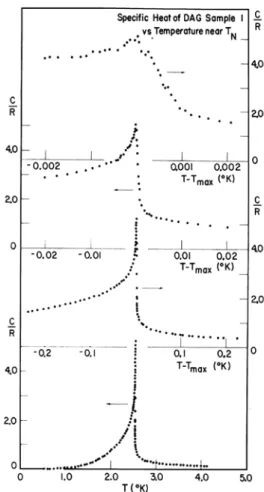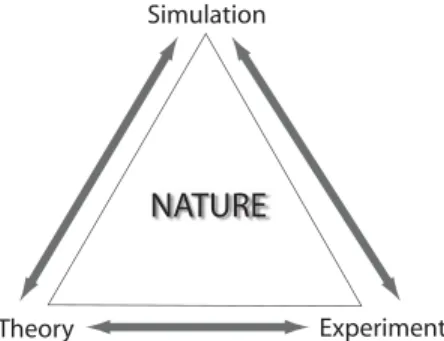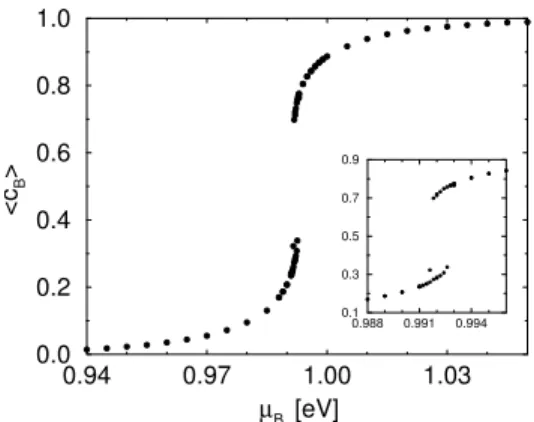What Do Monte Carlo Simulations Tell Us About Compressible Ising Models?
D. P. Landau
Center for Simulational Physics, The University of Georgia, Athens, GA 30622, U.S.A.
Received on 16 September, 2006
Monte Carlo simulations have begun to illuminate the nature of phase transitions and universality classes for compressible Ising models. A comprehensive analysis of a Landau-Ginsburg Wilson hamiltonian for systems with elastic degrees of freedom predicts that there should be four cases with different behavior, depending upon symmetries and thermodynamic constraints. We shall describe the results of careful Monte Carlo simulations for a simple compressible Ising model that can be easily modified to correspond to each of the four cases.
Keywords: Compressible Ising model; Phase transition; Monte Carlo; Finite size scaling
I. INTRODUCTION
The study of critical phenomena in magnetic systems is a mature endeavor with quite substantial results from both the-ory and experiment. In addition, high resolution Monte Carlo studies of Ising models have provided quite precise values for critical temperatures and exponents for several different three dimensional Ising models. In many cases, however, the ex-perimental data deviate from theoretical predictions close to Tc. One possible explanation is that real materials have
elas-tic, not rigid, lattices. High resolution measurements of the specific heat of DAG (dysprosium aluminum garnet) [1] show that quite close to the critical point the apparently diverging peak becomes rounded, see Fig. 1, in spite of the fact that the single crystals that were used were of exceedingly high qual-ity. Is the elastic nature of the lattice the culprit? The question of what happens when the “lattice” is allowed to be compress-ible has long been the subject of theoretical scrutiny (the the-oretical background is reviewed elsewhere [2–4]). Of course, the equivalence between the Ising model and the binary alloy model adds to the general interest in the problem.
One simple example is theSi/Gealloy for which the cova-lent interactions give rise to strongly directional nearest neigh-bor bonds that dominate the behavior. (Ising spinsσi=±1
are then equivalent toSiorGeatoms, respectively; and hence, the concentration ofGe atoms plays the role of the magne-tization in the corresponding magnetic system. In the same vein, the chemical potential is equivalent to the magnetic field in the magnetic interpretation.) The appropriate model con-tains both two-body and three-body interactions so that both the bond lengths and bond angles are somewhat constrained. The particular values of the constants were determined by fit-ting to the properties ofSi/Gealloys, but the goal here is actu-ally to determine the behavior of a generic compressible Ising model. Of course, it remains to be seen if this type of model fully encompasses the range of physical behavior characteris-tic of “compressible Ising models” or if the problem is more subtle.
A comprehensive analysis of a Landau-Ginsburg Wilson hamiltonian for systems with elastic degrees of freedom de-termined [3, 4] that there were four distinct cases that would exhibit quite different behavior. These depend upon symme-tries (e.g. the coupling between the elastic and magnetic de-grees of freedom) as well as the thermodynamic constraints
FIG. 1: Specific heat of DAG at various degrees of temperature res-olution. (From Ref. 1.)
and are listed in Table I.
Sim-NATURE
Simulation
Experiment Theory
FIG. 2: Schematic view of modern approaches to the study of physics and their interrelationship.
TABLE I: Predicted nature of critical behavior for compressible Ising model with different symmetries/constraints [3, 4]
Type Ferromagnet Antiferromagnet
constant P mean-field (MF)-like 1st order
constant V two trans. lines, MF [5] Fisher renorm.
ulational Physics.
II. MODEL AND METHOD
In these studies the Ising model-binary alloy equivalence is used, and for the Ising ferromagnet Si/Ge alloys correspond to a physical example. “Spins” are placed on a distortable di-amond net with 8 sites per unit cell. The simulation cell con-tainsL×L×Lunit cells and the boundary conditions were periodic. Multiple hamiltonians were considered but all con-tained distance dependent two-body and three-body terms. The initial choice was the Keating [7] interatomic potential, whose “stiffness” parameters E and Awere determined by the macroscopic elastic constants of the crystal and which has been used to describe the structural properties of mixed sys-tems [2].
H =Hext.+Hchem.+Hel.,bonds+Hel.,angl (1) with
Hext.=−µA
∑
i
δS
i,+1−µB
∑
i
δS
i,−1 (2)
(Kronecker’sδ), whereµAandµBare chemical potentials
Hchem.=
∑
i−j
ε(Si,Sj), (3)
where theε(Si,Sj)are chemical binding energies
Hel.,bonds=
∑
i−j
E(Si,Sj)
r2i j−R20(Si,Sj) 2
(4)
whereE(Si,Sj)are bond ”stiffnesses”,R0(Si,Sj)ideal lattice
neighbor distances, and Hel.,angl=
∑
i−j−k
Ai,j,k(ri j·rk j+R0(Si,Sj)R0(Sk,Sj)/3)2 (5)
whereAi,j,k(Si,Sj,Sk)are “angular stiffnesses”. In these
equa-tions,i–jdenotes a bond between nearest neighborsiand j, whilei–j–kdenotes the angle of the nearest–neighbor bonds i–jandj–kwith vertex at sitej. The vectorri j=ri−rj, where
riis the position of sitei. Additional degrees of freedom are
the linear sizes of the simulation cellΛx,Λy and Λz which
fluctuate if the pressure is held fixed, e.g.P=0. These simu-lations were repeated and extended [8] using the Stillinger-Weber potential [9]. Also containing two-body and three-body interactions, this potential has the decided advantage that a simple Stillinger-Weber alloy expands upon heating whereas a Keating model shows unphysical shrinkage with increasing temperature.
The Monte Carlo sampling [10] was implemented as fol-lows: For a single particle of typeSiat positionri, a new type
S′
iis randomly chosen as is a slightly displaced new position
ri′, while keeping the other particles and the simulation box
dimensions fixed. This random trial move is accepted or re-jected according to the usual Metropolis criterion. After all particles have been considered, new box dimensionsΛ′
x,Λ′y
andΛ′
zare randomly chosen. The Metropolis acceptance
cri-terion uses
∆He f f=∆H−NkBTlnΛ
′ xΛ′yΛ′z
ΛxΛyΛz, (6) where∆H is the energy change associated with this global distortion of the system and the latter term describes the change in translational entropy due to a volume change. (Since the total number of particles was constant, although the number ofSiandGewere not individually fixed, the sim-ulations were performed in the semi-grand canonical ensem-ble.) Constant volume simulations were performed by simply turning off volume changing moves. In such cases the fixed volume was set at about 3/4 of the way between the volumes for pureSiand pureGeatT=0. For some simulations paral-lel tempering [11, 12] was implemented to overcome thermal slugishness. Intially runs of only 104MCS were used to de-termine parameter ranges of interest, but runs of length 105 -107MCS or more were used for more serious data taking.
Because of the Ising model - binary alloy model equiva-lence, either the magnetic fieldH or the chemical potential difference∆µcan be used for presenting results. Similarly, ei-ther the magnetizationMor the Ge concentrationcGeprovide
a measure of the order parameter. However, it should be noted that the elastic degrees of freedom result in a non-equivalence of the constant-Mand constant-Hensembles. This has to do with the fact that the usual grand-canonical particle bath has the properties of a fluid, while it would have to have the prop-erties of a solid (i.e., in particular, apply coherency stresses) in order to ensure equivalence. This difference was first noted by Vandeworp and Newman [13].
0.988 0.991 0.994 0.1
0.3 0.5 0.7 0.9
0.94 0.97 1.00 1.03
µB [eV] 0.0
0.2 0.4 0.6 0.8 1.0
<c
B
>
FIG. 3: Concentration dependence on chemical potential as
deter-mined from Monte Carlo simulations atT=0.026 eV. for the
ferro-magnetic compressible Ising model at constant pressure with a Keat-ing potential. (From Ref. 2)
at fixed chemical potential for higher temperatures. Because of pronounced hysteresis at low temperatures, thermodynamic integration was used to find the intersection of the free ener-gies and hence the location of the transition. At higher tem-peratures histogram reweighting [14] was used to locate the transition at, or near, the critical point. Of course, in a finite system transitions are rounded and shifted [15], so finite size scaling was then used to extrapolate to the thermodynamic limit.
III. RESULTS
For the compressible ferromagnet at constant pressure, the transition at low temperatures was strongly first order and free energy integrations were needed to locate the transition. At higher temperatures the hysteresis was much smaller and a “law of equal areas” could be used to estimate the location of the transition. An example is given in Fig. 3, where the data are shown using binary alloy variables. At intermedi-ate temperatures the hysteresis shown in the inset can only be seen using a fine scale observation. Since the up / spin-down symmetry of the rigid Ising model is no longer valid, the search for the critical point necessitated scanning the two-dimensional chemical potential-temperature space. With the aid of histogram reweighting, the critical point was located and excellent finite size scaling was obtained using mean-field exponents. Clear, systematic deviations were found for other choices of exponents so they could be excluded. The 4th or-der cumulants of the oror-der parameter were also found to cross at a different value than the rigid Ising one (U4∗∼0.47), but the crossing point matched the mean field value quite well. See Fig. 4. The conclusion that the critical behavior was mean field-like was later found in the analysis of the Landau-Ginsburg-Wilson Hamiltonian mentioned earlier.
Qualitatively similar results were obtained for the com-pressible Ising ferromagnet when the Stillinger-Weber poten-tial is substituted for the Keating potenpoten-tial [8]. Although the
0.026 0.027 0.028
kB T [eV] 0.1
0.2 0.3 0.4 0.5 0.6 0.7
U4
N = 512 N = 2744 N = 8000
FIG. 4: Crossing of 4th order cumulants of the concentration for the compressible Ising ferromagnet at constant pressure (From Ref. 2)
0.0 0.5 1.0 1.5 2.0 2.5 3.0
N1/2 |T/Tc-1|
0.1 0.2 0.3 0.4 0.5 0.6 0.7
U4
(T)
N = 512 N = 2744 N = 4096 N = 8000
FIG. 5: Finite size scaling of the 4th order cumulants of the con-centration for the compressible Ising ferromagnet with a Stillinger-Weber potential at constant pressure. (From Ref. 8)
scales of interest for the temperature and chemical potential change, the asymptotic behavior of the normalized thermody-namic quantities as the critical point is approached does not. Finite scaling of the reduced fourth order cumulant, shown in Fig. 5, demonstrates how well mean-field exponents work in this situation as well.
For the constant volume case, the analysis of the Landau-Ginsburg-Wilson Hamiltonian [3] suggests that two transi-tions should occur at low temperatures: one from aSi-rich state to one that is about equal inSiandGeconcentration, fol-lowed by a second transition to a state that was almost pure Ge. In contrast, however, the Monte Carlo data obtained by sweeping chemical potential at low temperatures revealed a relatively smooth increase of theGe-concentration with vary-ing chemical potential and no apparent transition. However, a more careful, high resolution study showed that the low temperature data indeed indicated very slight, smeared out hysteresis loops for the range of chemical potential between
0 0.2 0.4 0.6 0.8 1
Ge concentration
0.001 0.002 0.003 0.004
Temperature (eV)
from hysteresis (L=10) "heating-PT" (L=12) from hysteresis (L=10)
0.38 0.4 0.42 0.44 0.46 0.48
∆µ (eV)
0.001 0.002 0.003 0.004
Temperature (eV)
from hysteresis (L=10) "heating-PT" (L=12) from hysteresis (L=10)
(a)
(b)
"ORD" "ORD"
DIS DIS
FIG. 6: Phase diagrams: (left) chemical potential-temperature space; (right) concentration-temperature space (shaded areas show regions where hysteresis is visible). (From Ref.16)
c(Ge)~0.55
x
z
y
FIG. 7: Formation of slabs of the minority species. (Top)∆µ=0.472
eV; (bottom)∆µ=0.410 eV.T=0.0029 eV. for both cases. OnlySi
atoms are shown, and they are greyscale coded vs depth. (After Ref. 16)
and was matched by relatively similar hysteresis in the internal energy as well. The hysteresis slowly diminished as the tem-perature increased, and at substantially higher temtem-perature it disappeared completely for the concentration within the range of sizes that could be studied. Even so, an examination of the distribution of nearest neighbors of each species showed that a double peaked distribution remained below some chemical potential dependent temperature. It thus appeared as though there was a phase transition separating the low temperature, medium concentration and the disordered states over a wide range of chemical potential (see Fig. 6) but the nature of the transition was perplexing.
Ising model critical exponents, for the compressible Ising an-tiferromagnet at constant volume [19].
These results could only be understood by augmenting the numerical data with “snapshots” of the system. The visual-ization program AViz, developed at the Technion [17, 18], was used to produce many views of the system for different conditions. Typical snapshots of the system (see e.g. Fig. 7) showed, unexpectedly, thatSirich regions formed slabs of ap-proximately fixed thickness. Instead of the thickness growing with enhanced concentration, additional slabs would simply
FIG. 8: Finite size scaling of the order parameter for the compress-ible Ising antiferromagnet at constant volume. (From Ref. 19)
0.311 0.312 0.313
Temperature (eV)
0.44 0.46 0.48 0.5 0.52
U4
L=6
L=8 L=10 12 14 16 18 20 24 24 20 18 16 14 12 L=10 L=8
L=6
Crossing point
FIG. 9: Cumulant crossing for the compressible antiferromagnet at constant pressure. (From Ref. 4)
analysis of this case in Ref. 3 (incorrect assumption of a finite interfacial tension), the physical mechanism which produces the observed slab formation still needs a clearer explanation.
For Monte Carlo simulations of compressible Ising antifer-romagnets, essentially the same model (distortable diamond net with a Stillinger-Weber potential) was used. This was done so that as few differences as possible were introduced relative to the ferromagnetic model; however, it was necessary to change the sign and magnitude of the interaction between unlike species to produce an antiferromagnetic ground state. (Of course, in this case the resultant alloy is no longer related in any way toSi/Geand must be regarded merely as a model of purely theoretical interest.) The phase boundaries were first estimated for modest size lattices, and then more careful runs were made for specific values of chemical potential or tem-perature. At both constant volume and constant pressure the resultant phase boundaries separating the ordered (antiferro-magnetic) and disordered phases were 2nd order. Careful fi-nite size analyses of the critical behavior revealed rigid Ising exponents. For example, Fig. 8 shows a finite size scaling plot, made with rigid
Quite similar behavior was found for the compressible Ising antiferromagnet at constant pressure [4]. Furthermore, as shown in Fig. 9, cumulant crossings for both cases occurred at the value found previously for a rigid Ising model. Since no indicationof crossover to any other kind of behavior was seen, substantially larger systems would probably be required to see some other possible kind of asymptotic behavior, if it exists! In such a case the computational resources needed for extending studies of the present model would be orders of magnitude beyond the capability of current computer
re-sources. Thus, this remains a challenge for future generations of students.
IV. CONCLUSIONS
Monte Carlo studies of Ising models on a distortable dia-mond net have provided a test of the “global” nature of the-oretical predictions. For the ferromagnet at constant pressure the critical behavior is mean-field-like. For the constant vol-ume forromagnet a closed first order line was found instead of the two predicted first order lines, terminating in critical points. In the “ordered” phase, the less favorable species forms slabs of approximately fixed thickness, the number of which increases with increasing concentration. For both con-stant pressure and concon-stant volume the compressible Ising an-tiferromagnet showed a closed, Ising like 2nd order phase boundary separating the ordered and disordered states. Of course, these studies were restricted to a single type of com-pressible Ising model, and the general classifications of such models may be more complex. Much remains to be done.
Acknowledgments
We thank B. D¨uenweg, M. Laradji, F. Tavazza, L. Can-navacciuolo, J. Adler, and X. Zhu for extremely fruitful col-laborations. This work was supported by NSF grant No DMR-0341874.
[1] D. P. Landau, B. E. Keen, B. Schneider, and W. P. Wolf, Phys.
Rev.3, 2310 (1971).
[2] B. D¨unweg and D. P. Landau, Phys. Rev. B48, 14182 (1993).
[3] B. D¨unweg,Computersimulationen xu Phasen¨uberg¨angen und
kritischen Ph¨anomenen, Habilitationsschrift, U. Mainz (2000). [4] X. Zhu, F. Tavazza, D. P. Landau, and B. D ¨unweg, Phys. Rev.
B72, 104102 (2005).
[5] This prediction relied on the assumption (Ref. 3) that the inter-facial tension between the Si-rich and Ge-rich phases is finite. This has turned out to be incorrect. There is, instead, a complete suppression of capillary waves [6], and also a phase behavior which differs substantially from that assumed in Ref. 3. [6] B. J. Schulz, B. D¨unweg, K. Binder, and M. M¨uller, Phys. Rev.
Lett.95, 096101 (2005).
[7] P. N. Keating, Phys. Rev.145, 627 (1966).
[8] M. Laradji, D. P. Landau, and B. D ¨unweg, Phys. Rev. B51,
4898 (1995).
[9] F. H. Stillinger and T. A. Weber, Phys. Rev. B31, 5262 (1985).
[10] D. P. Landau and K. Binder,A Guide to Monte Carlo
Simula-tions in Statistical Physics, 2nd Edition(Cambridge U. Press, Cambridge, 2005).
[11] K. Hukushima and K. Nemoto, Journal Phys. Soc. of Japan65,
1604 (1996).
[12] R.H. Swendsen and J.S. Wang, Phys. Rev. Lett. 57, 2607
(1986).
[13] E. M. Vandeworp and K. E. Newman, Phys. Rev. B52, 4086
(1995); E. M. Vandeworp and K. E. Newman, Phys. Rev. B55,
14222 (1997)
[14] A.M. Ferrenberg and R.H. Swendsen, Phys. Rev. Lett.63, 1195
(1989).
[15] V. Privman (Ed.)Finite Size Scaling and Numerical Simulation
of Statistical Systems, World Scientific, Singapore, 1990.
[16] F. Tavazza, D. P. Landau, and J. Adler, Phys. Rev. B70, 184103
(2004).
[17] J. Adler,A. Hashibon, and G. Wagner,Recent Developments
in Computer Simulation Studies in Condensed Matter Physics,
XIV, ed. D. P. Landau, S. P. Lewis, and H.-B. Sch ¨uttler, p.160
(Springer, Heidelberg, 2002).
[18] J. Adler, Comput. in Sci. and Engineering,5, 61 (2003)
[19] L. Cannavacciuolo and D. P. Landau, Phys. Rev. B71, 134104



